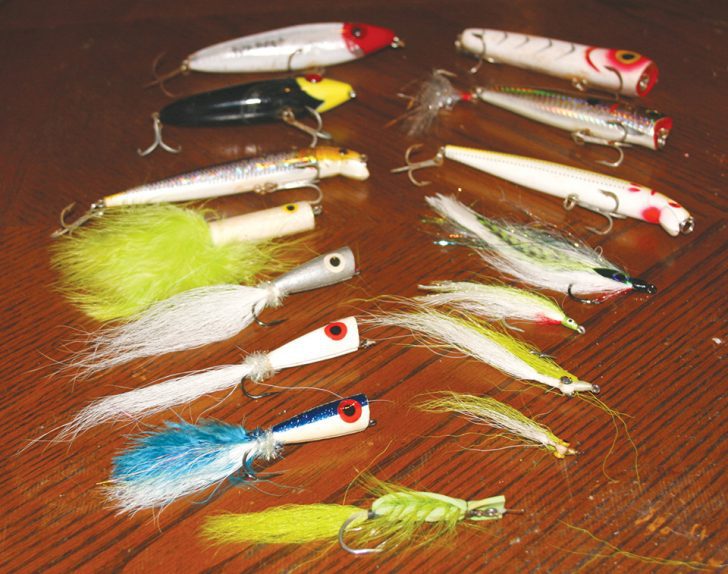By Joseph Albanese
Some of the best fishing of the early season takes place in the skinny waters of the salt marsh. As the water is shallower, everything is magnified. The importance of tidal stage, sun, and even the color and composition of the bottom are exaggerated. Many variables must line up, but when they do it can provide lights out fly and light tackle fishing for hungry migratory striped bass in the salt marshes of the Northeast.
In stark contrast to the deeper waters of the Atlantic, most of the South Shore’s salt marshes are 4 to 6 feet deep on all but the steepest of tides. As such, stealth is key. Your approach should be as cautious as possible. Come off plane well before the area you plan to fish. If possible, turn your motor off without shifting out of gear and drift into place. The clunking of your boat’s transmission is a proven way to scare fish. If you have a trolling motor or push pole, this is definitely the time to use it.
Tide stage is of the utmost importance. To put up big numbers, you need to time the tide almost perfectly. I have found, that in most circumstances, the best time to fish the marsh is an hour before the peak of high, staying until you run out of water. The exception to that is on a moon tide, when the water rises far enough above the grass that stripers fan out in pursuit of baitfish. This is not to say you won’t pick up a fish here and there, you just won’t connect like you will when the high marsh starts to drain, concentrating food sources in the deeper channels.
Earlier I mentioned the substrate. Dark mud absorbs light energy more effectively than a sand bottom, or even a lighter colored mud bottom. These areas will heat up faster than the surrounding bottom. You want to use this to your advantage, looking for areas of ideal temperature.
I have found the magic number to be 64 degrees. According to my logs, the fishing has broken wide open when the water temperature hits that number. It seems to be just warm enough to stimulate their metabolism, but not warm enough to make them lethargic. The action seems to be white hot until the temperature hits 70 or so, although you can continue to catch fish in the back when periods of high tide coincide with dawn and dusk. There’s usually a few days a month that can be productive even in the warmest months.
While most of these fish will be 22 to 32 inches, you can also tangle with some truly outsized bruisers in the marsh. So you should match your tackle to the size of the fish you’ll likely encounter, with a little extra backbone in case you do battle with a heavyweight. While you’re not dealing with rocks or bridge abutments, there are plenty of structures for fish to break you off on. I prefer the delicate presentation afforded by a fly rod. Most anglers opt for a 9- or 10-weight, as they are versatile and have good backbone if you happen into a larger specimen. As the water is shallow, a floating line is best, but a slow sinking intermediate will work. I used to bother with tapered leaders, but no longer. I run 4 to 6 feet of 15-pound fluorocarbon.
For flies, I like topwater stuff the best. The Gartside Gurgler is a fantastic choice, as it moves a lot of water and is easy to cast. Hard-body poppers are a close second, with deer hair divers also in the mix. I don’t often use subsurface flies, but I will throw a crab pattern every now and then. Clouser Minnows and Deceivers are also good choices, but I only resort to them when I know fish are around but I can’t coax them to the surface. As far as retrieves go, start gentle. If finesse doesn’t produce, ratchet it up a bit to create more disturbance. Don’t be afraid to cast to the same spot a few times.
This game is equally suited to light tackle. Medium-action rods in the 6- to 7-foot range are ideal. Spinning and baitcasting both work, but baitcasting has the advantage when working topwater baits. Spinning reels are prone to creating loops when slack is created, as is often the case with poppers and walk-the-dog type baits. Braided line works well, as the stretch-free properties lend themselves to working a plug. A 6-foot section of 10- to 20-pound-test fluorocarbon serves well as a leader.
Again, topwater is king. There are subsurface that work, such as a shallow-running Bomber or Redfin, but the depth and presence of sea lettuce often precludes their use. Offerings from Mirrolure have been my go-to for years. Although originally designed for snook and redfish, they are deadly on stripers and bluefish. The walk-the-dog style baits have been my best producers. Zara Spooks also work well. If there is a chop on the water, I will go to a popper. Yo-Zuri is my favorite. Smack It has a good, lower-cost option. You want to start out with as much finesse as possible. Then you can be a bit more aggressive, attempting to attract fish from farther away. Hit the marsh this spring. It’s one of the best times to catch fish in shallow water on light tackle. Most of the pleasure boaters haven’t put their boats in yet, so you can have some solitude. If you can line up all of the variables, you can take part in some of the best fishing of
the year.
